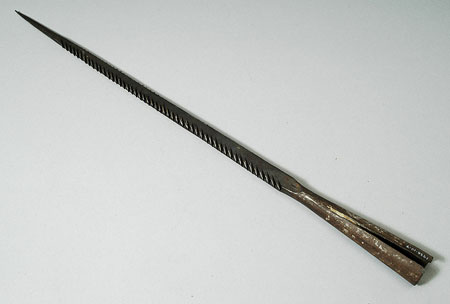Accession Number:
1936.10.7
Country:
Sudan
Region:
[Southern Sudan]
Cultural Group:
Nuer European
Date Made:
By 1936
Materials:
Iron Metal
Process:
Forged (Metal) , Hammered , Socketed
Dimensions:
L = 476, body max W = 15.3, max th = 10, socket diam = 27 x 26 mm [RTS 27/6/2005].
Weight:
360.1 g
Local Name:
bith?
Other Owners:
This object was probably collected in 1935 or 1936, when Evans-Pritchard held a research fellowship from the Leverhulme Trust (see E.E. Evans-Pritchard, 1940, The Nuer) [RTS 28/9/2004].
Field Collector:
Edward Evan Evans-Pritchard
PRM Source:
Edward Evan Evans-Pritchard
Acquired:
Donated 1936
Collected Date:
1935 - 1936
Description:
Spearhead made from a single piece of iron, and consisting of a narrow, round sectioned point, gradually tapering out to the body, which has been hammered flat on all sides to create a rectangular section.
This has a series of sharp downward pointing barbs chiselled down opposite sides of its upper and lower faces.
The base has been hammered flat, and bent round to form an oval sectioned socket with an open seam running up the front; this socket gradually widens towards is lower end.
The spearhead is complete and intact; the metal is a mid gray colour (Pantone 877C) with some traces of reddish surface rust.
It has a weight of 360.1 grams, and is 476 mm long, with a body width of 15.3 mm and thickness of 10 mm, and a socket measuring 27 by 26 mm in diameter at its base.
This spearhead was used for fishing, and was manufactured in Europe.
Collected by Edward Evan Evans-Pritchard in either 1935 or 1936, when Evans-Pritchard held a research fellowship from the Leverhulme Trust (see E.E. Evans-Pritchard, 1940, The Nuer ). While he does not give the Nuer name for this type of object, we are told that the iron spearhead was 'of European make' (unlike 1936.10.6).
Evans-Pritchard describes the Nuer use of fish to supplement to their diet, including various methods of catching them (E.E. Evans-Pritchard, 1940, The Nuer, pp 70-72, pls IX-X, and XXIIa-b). Another source from the same period gives the Lak Nuer term for a fishing spear as bith , which is the same term as that used by the Dinka (Nebel 1979, Dinka-English Dictionary, p. 16); these are said to have been of universally high value amongst different Nuer groups, who always made the points out of iron, as other materials were difficult to haft successfully on an object that would frequently get wet (P.P. Howell, 1947, "On the Value of Iron Among the Nuer", Man 47, p. 133). For photographs of the Dinka using this type of spear, see J. Ryle, 1982, Warriors of the White Nile: The Dinka, pp 106-109.
For fishing spears of similar design, see 1936.10.6 (Nuer, with slightly different style of barbs, and complete with spear shaft), 1942.8.61 (unattributed, decorated), 1961.9.8 (Shilluk, more elaborate lower body) and 1979.20.109 (Dinka Tuich).
Rachael Sparks 29/8/2005.
Collected by Edward Evan Evans-Pritchard in either 1935 or 1936, when Evans-Pritchard held a research fellowship from the Leverhulme Trust (see E.E. Evans-Pritchard, 1940, The Nuer ). While he does not give the Nuer name for this type of object, we are told that the iron spearhead was 'of European make' (unlike 1936.10.6).
Evans-Pritchard describes the Nuer use of fish to supplement to their diet, including various methods of catching them (E.E. Evans-Pritchard, 1940, The Nuer, pp 70-72, pls IX-X, and XXIIa-b). Another source from the same period gives the Lak Nuer term for a fishing spear as bith , which is the same term as that used by the Dinka (Nebel 1979, Dinka-English Dictionary, p. 16); these are said to have been of universally high value amongst different Nuer groups, who always made the points out of iron, as other materials were difficult to haft successfully on an object that would frequently get wet (P.P. Howell, 1947, "On the Value of Iron Among the Nuer", Man 47, p. 133). For photographs of the Dinka using this type of spear, see J. Ryle, 1982, Warriors of the White Nile: The Dinka, pp 106-109.
For fishing spears of similar design, see 1936.10.6 (Nuer, with slightly different style of barbs, and complete with spear shaft), 1942.8.61 (unattributed, decorated), 1961.9.8 (Shilluk, more elaborate lower body) and 1979.20.109 (Dinka Tuich).
Rachael Sparks 29/8/2005.
Primary Documentation:
Accession Book Entry
[p.
410] - 1936 [insert] 10 [end insert] E.
EVANS-PRITCHARD, M.A., Exeter College, Oxford.
- Specimens collected by himself in the EASTERN SUDAN, while travelling with a Grant from the
Rockefeller
Leverhulme Trustees, viz: [insert] 7 [end insert] - Head of a similar spear [fish-spear with native-made, long, multibarbed point of iron], but of European make, NUER.
Card Catalogue Entry [tribes]- EASTERN SUDAN, NUER TRIBE. Head of a fish-spear, with multi-barbed point of iron, of EUROPEAN make. Coll. by donor. d.d. E. E. Evans-Pritchard, 1936 [RTS 23/7/2004].
Pitt Rivers Museum label - Head of fish-spear. Made in Europe for trade. NUER, E. SUDAN. Pres. by E. Evans-Pritchard 1936 [rectanguar metal-edged tag, tied to object; RTS 24/6/2005].
Card Catalogue Entry [tribes]- EASTERN SUDAN, NUER TRIBE. Head of a fish-spear, with multi-barbed point of iron, of EUROPEAN make. Coll. by donor. d.d. E. E. Evans-Pritchard, 1936 [RTS 23/7/2004].
Pitt Rivers Museum label - Head of fish-spear. Made in Europe for trade. NUER, E. SUDAN. Pres. by E. Evans-Pritchard 1936 [rectanguar metal-edged tag, tied to object; RTS 24/6/2005].




